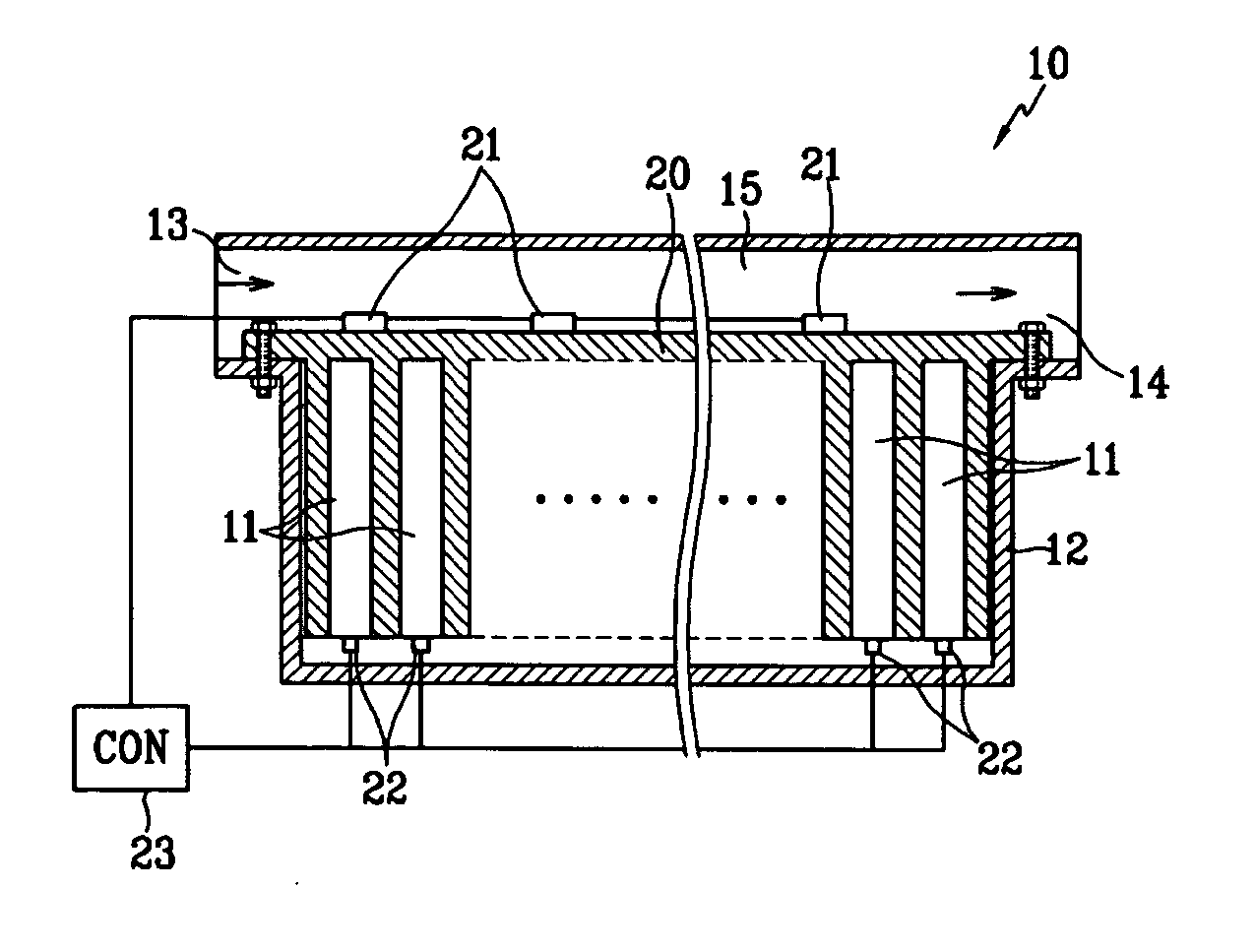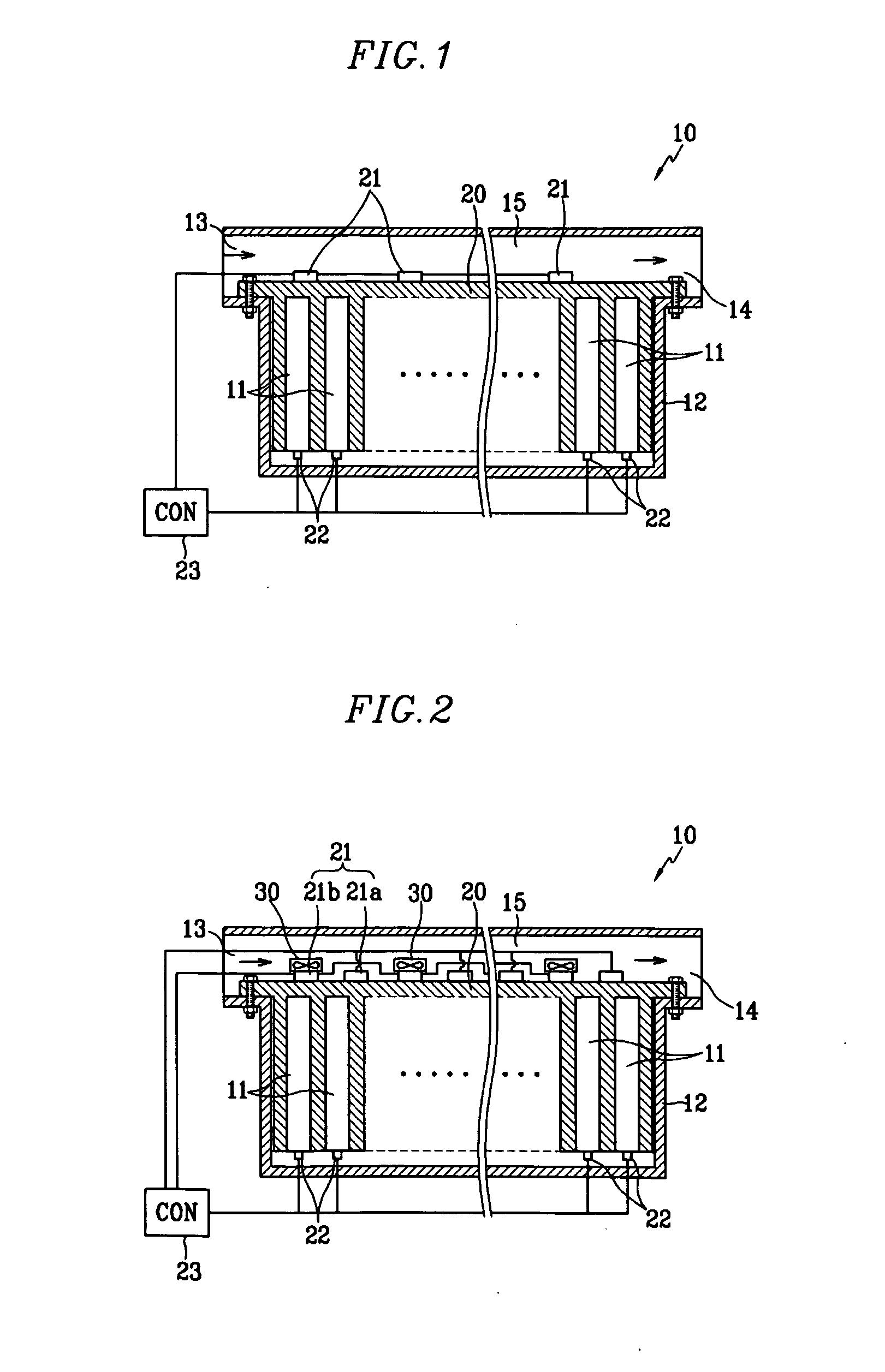System for controlling temperature of a secondary battery module
a secondary battery and temperature control technology, applied in the field of secondary batteries, can solve the problems of not considering geometric configuration, malfunction, and excessive and achieve the effects of reducing the size, actively responding, and efficient control of the temperature of the battery modul
- Summary
- Abstract
- Description
- Claims
- Application Information
AI Technical Summary
Benefits of technology
Problems solved by technology
Method used
Image
Examples
first embodiment
[0028]FIG. 1 is a schematic cross-sectional side view of a system for controlling the temperature of a secondary battery module (hereinafter “the system”) according to the present invention. The battery module 10 of the system includes multiple unit batteries 11, each having an electrode assembly having a positive plate, a negative plate, and a separator interposed between the positive plate and the negative plate to generate unit power, and a housing 12 receiving the unit batteries 11 which are spaced apart at a predetermined distance. Each of the unit batteries 11 of the present exemplary embodiment may be a lithium type secondary battery, such as a lithium-ion battery.
[0029] The housing 12 has an inlet 13 formed on one side thereof to allow air for controlling the temperature of the unit batteries 11 to flow in and an outlet 14 formed on the other side thereof to allow the air passing through the unit batteries 11 to flow out. An air duct 15 is formed between the inlet 13 and the...
second embodiment
[0045] Now referring to FIG. 2, the present invention is described. In this exemplary embodiment, the thermoelectric elements 21 mounted on the heat sink 20 each have a thermoelectric heating element 21a for heating the heat sink 20 and a thermoelectric cooling element 21b for cooling the heat sink 20 which are separated mounted. That is, in this exemplary embodiment, the thermoelectric element for increasing the temperature of the unit batteries 11 and the thermoelectric element for cooling the temperature of the unit batteries 11 are separated for their respective heating and cooling purposes.
[0046] Such a structure can enhance the battery module lifetime which otherwise would be diminished by overwork of the thermoelectric elements when one thermoelectric element alternatively performs both the heating and the cooling of the unit batteries 11. That is, if the cooling thermoelectric element and the heating thermoelectric element for the unit batteries are separately provided as de...
third embodiment
[0050]FIG. 3 shows a system according to the present invention. The battery module 48 of the system includes unit batteries 40, each with an electrode assembly having a positive plate, a negative plate, and a separator interposed between the positive plate and the negative plate to generate unit power. A housing 46 has an inlet 42 for receiving a temperature controlling air formed on one side thereof to control the temperature of the unit batteries 40, and an outlet 44 for discharging the air passing through the unit batteries 40 formed on the other side facing the one side. The unit batteries 40 are arranged and spaced apart at a predetermined distance. The system further includes a thermoelectric elements 50 formed in the inlet 42 of the housing 46 to increase or decrease the temperature of the air flowing inside the housing 46 through the inlet 42.
[0051] Also, the system includes temperature sensors 52 mounted on one side of the respective unit batteries 40 to detect the temperat...
PUM
| Property | Measurement | Unit |
|---|---|---|
| temperature | aaaaa | aaaaa |
| thermoelectric | aaaaa | aaaaa |
| temperatures | aaaaa | aaaaa |
Abstract
Description
Claims
Application Information
 Login to View More
Login to View More - R&D
- Intellectual Property
- Life Sciences
- Materials
- Tech Scout
- Unparalleled Data Quality
- Higher Quality Content
- 60% Fewer Hallucinations
Browse by: Latest US Patents, China's latest patents, Technical Efficacy Thesaurus, Application Domain, Technology Topic, Popular Technical Reports.
© 2025 PatSnap. All rights reserved.Legal|Privacy policy|Modern Slavery Act Transparency Statement|Sitemap|About US| Contact US: help@patsnap.com



